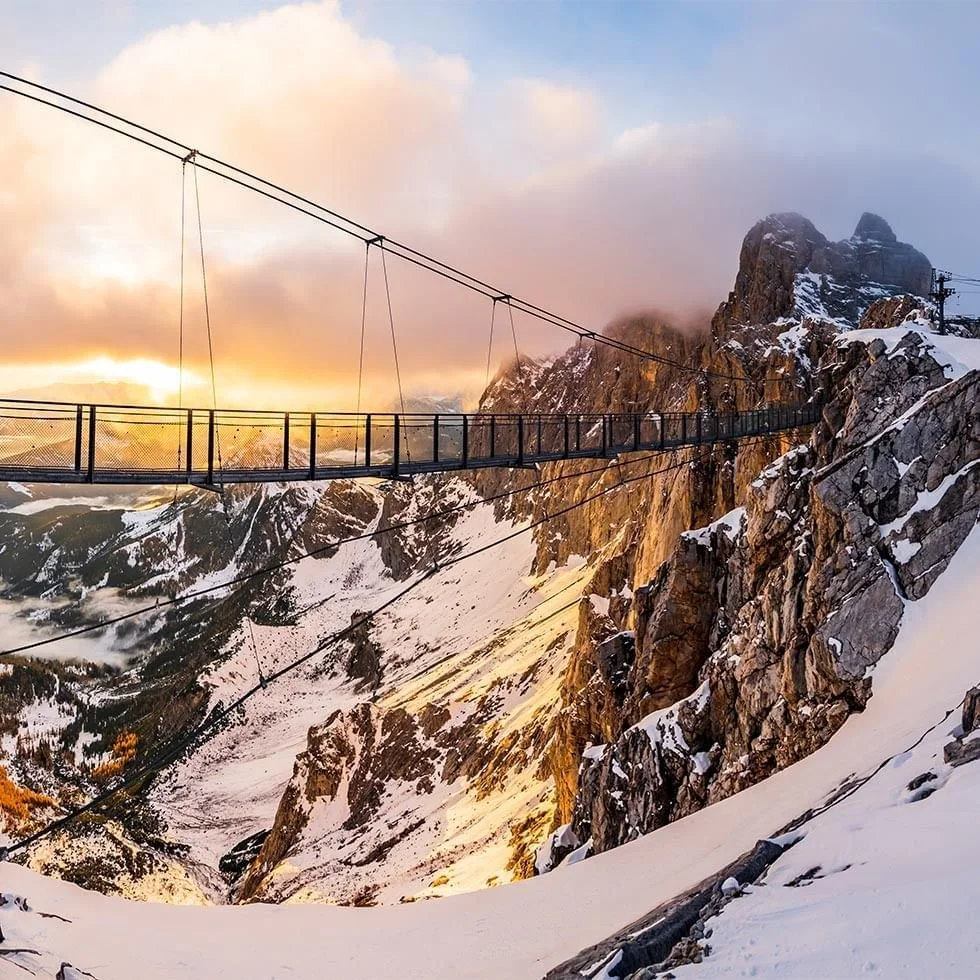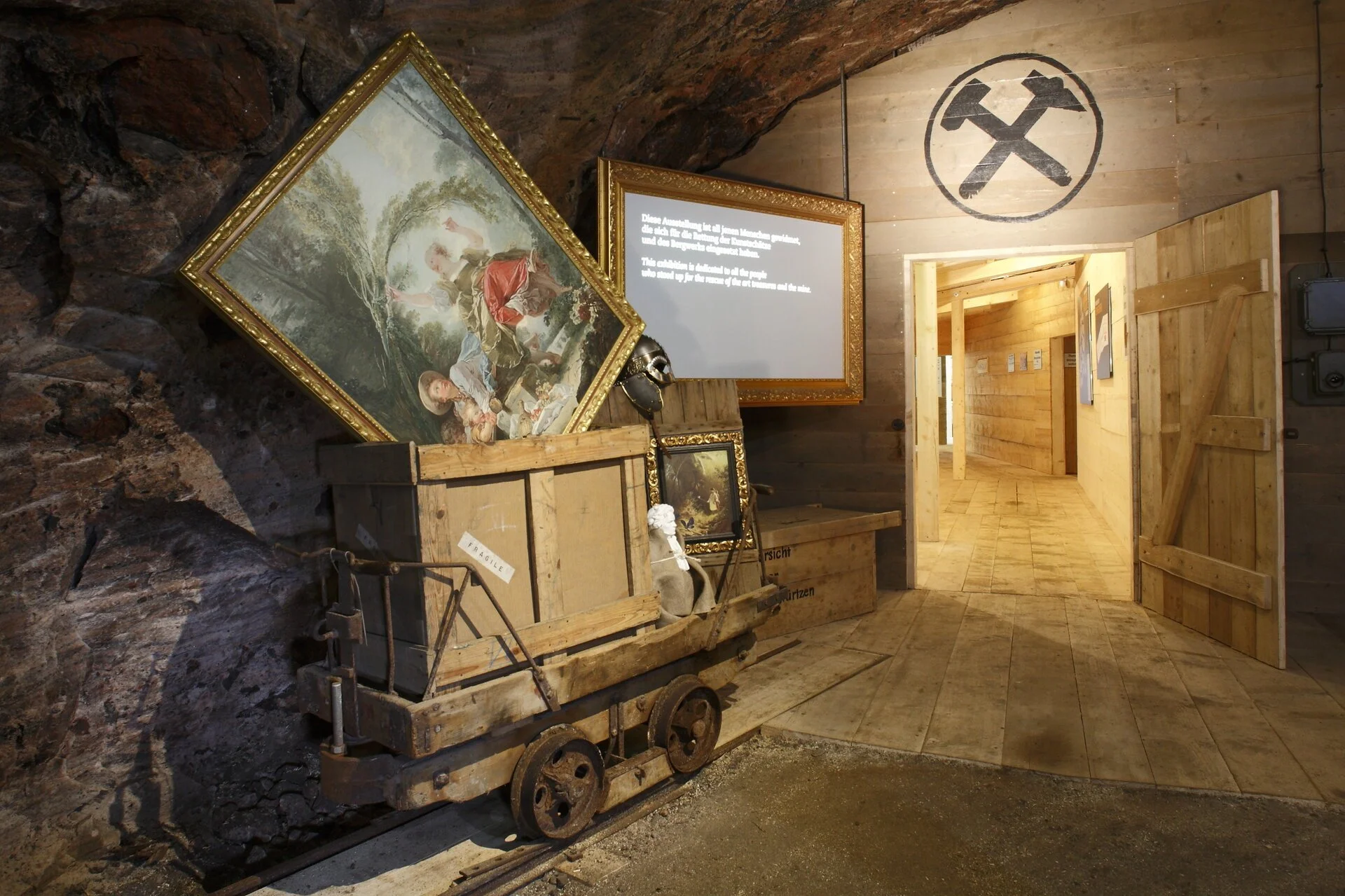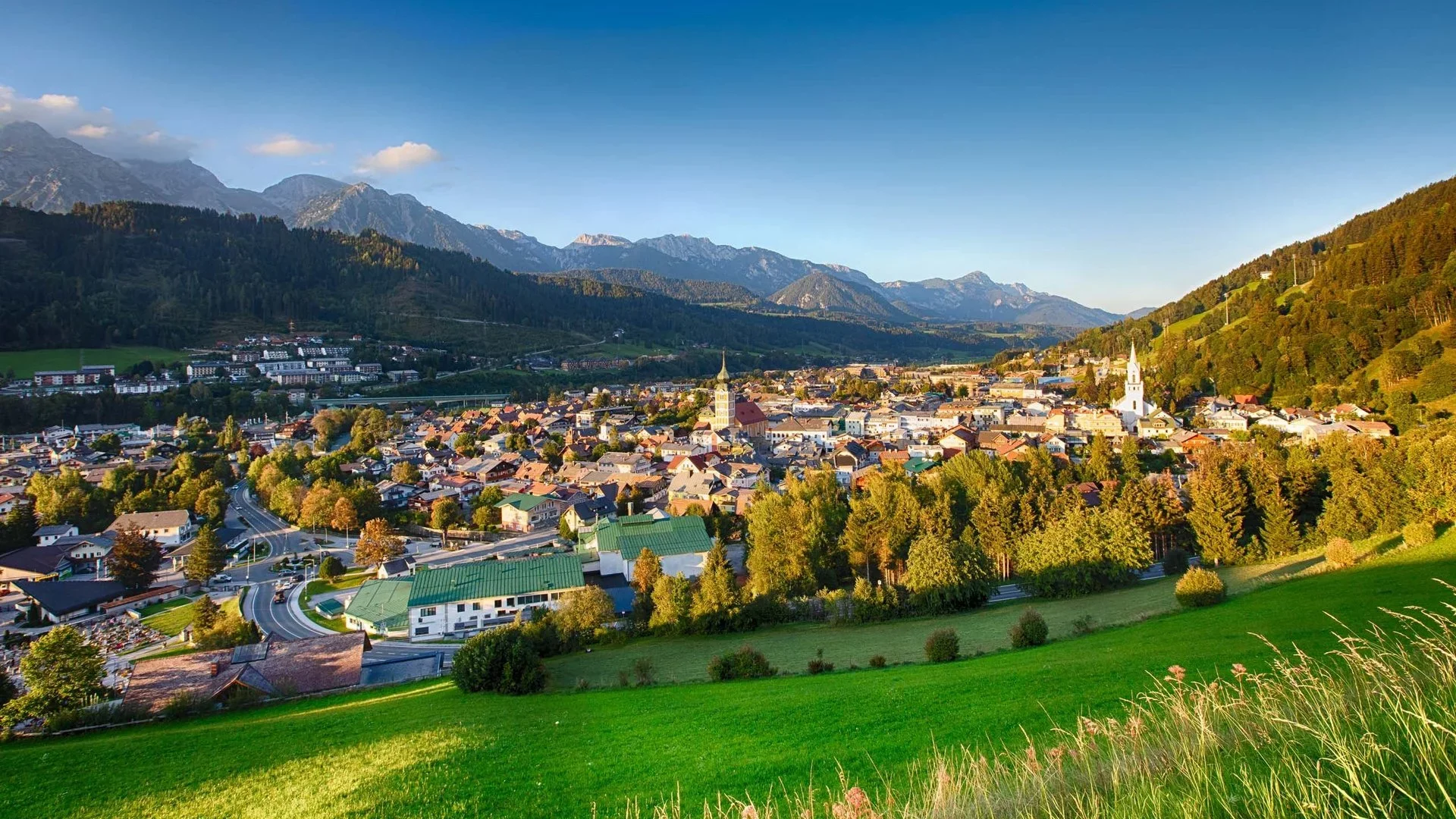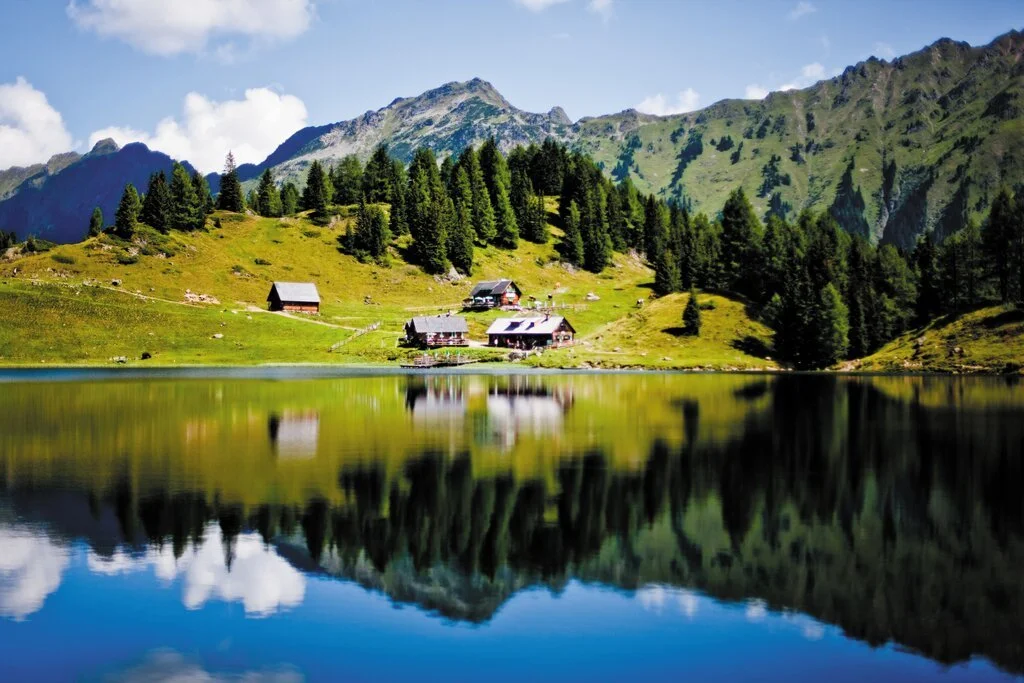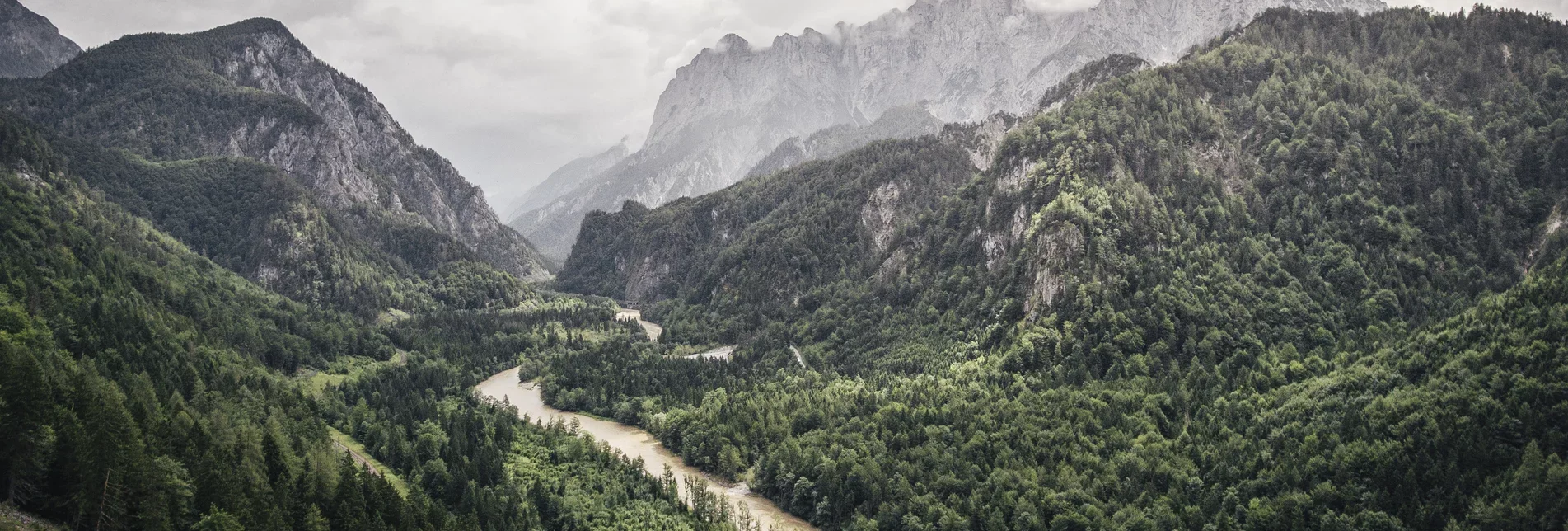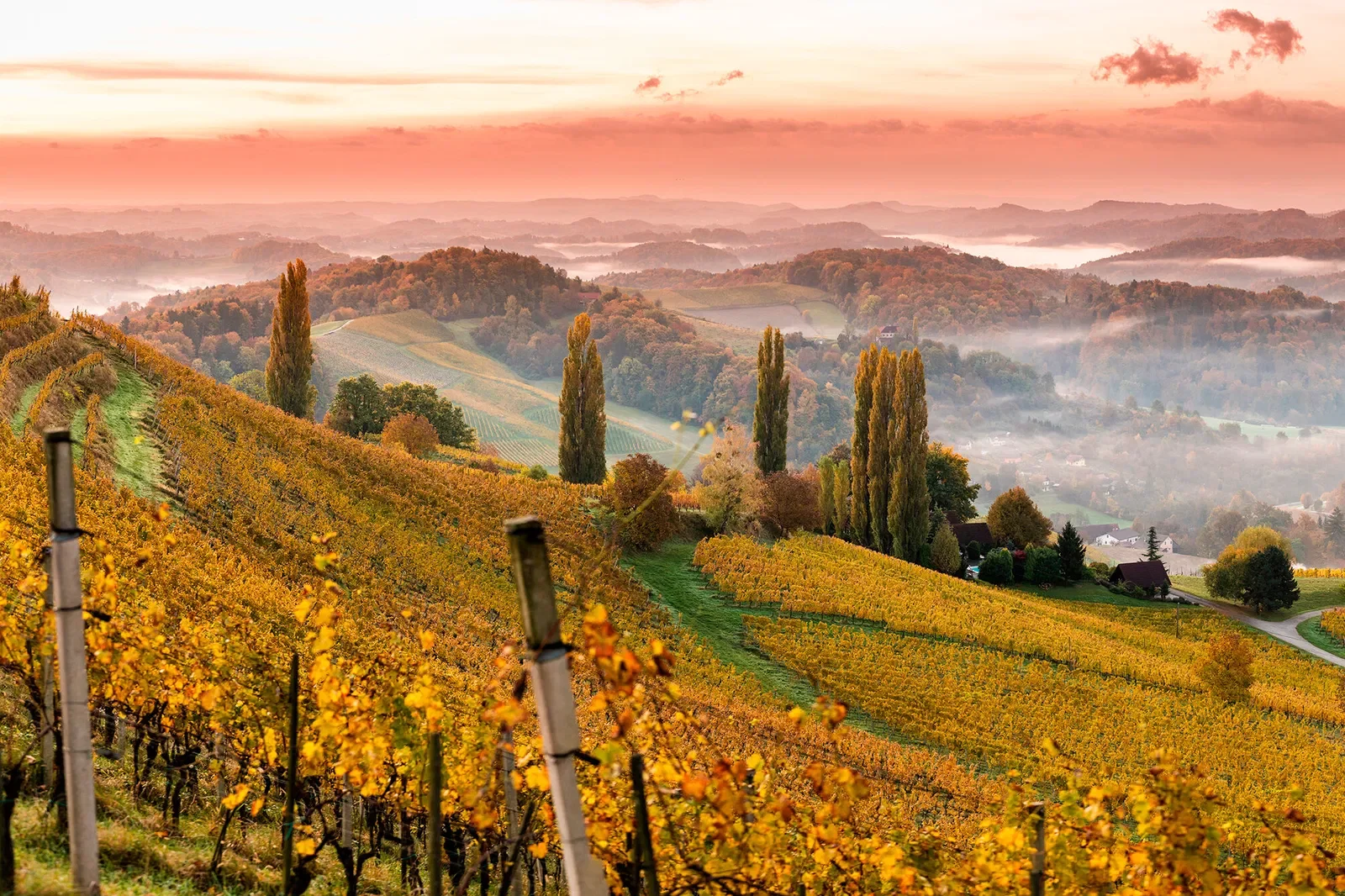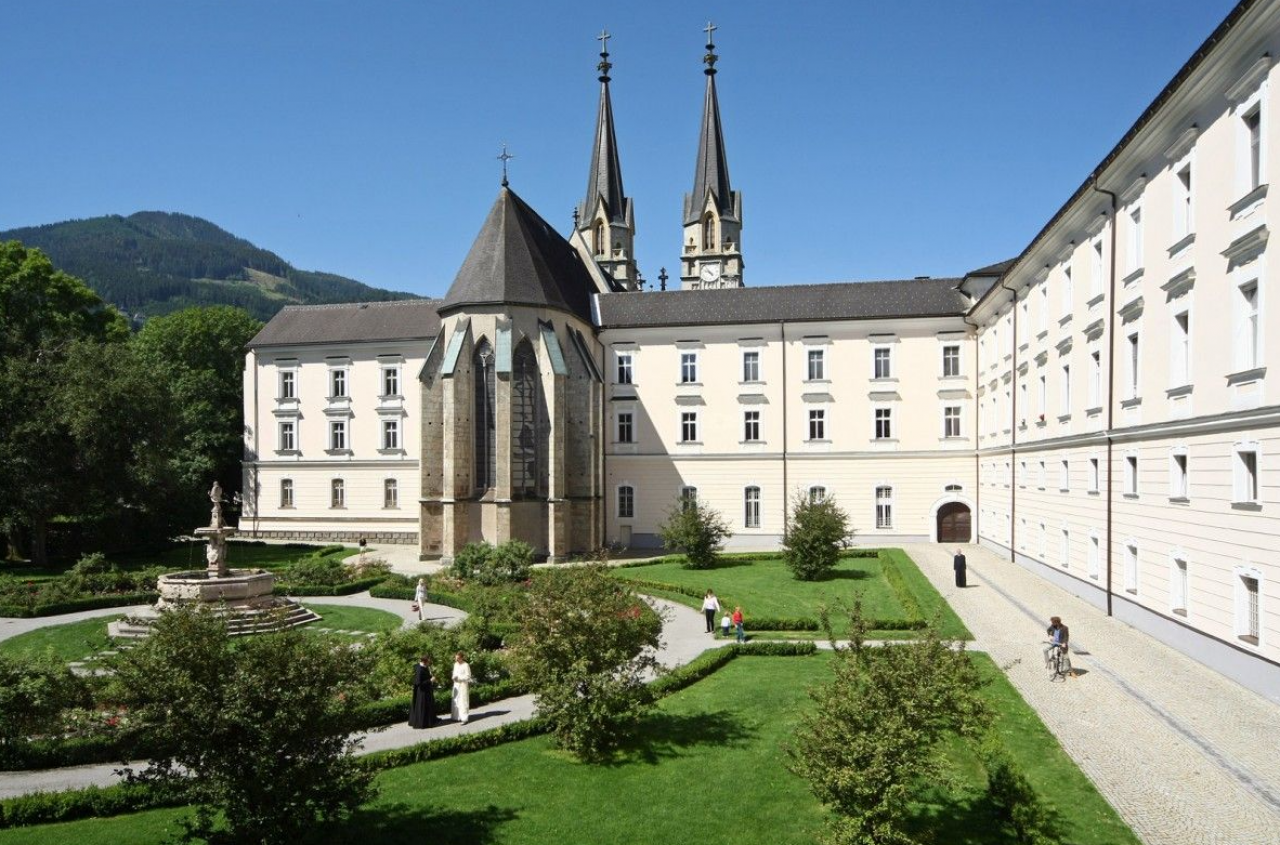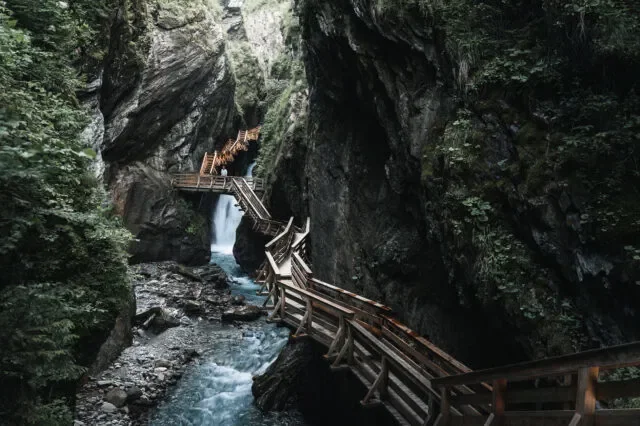Styria
Styria, often called the “green heart of Austria,” is a beautiful region known for its lush forests, rolling vineyards, and alpine peaks. Guests will discover a landscape that blends natural beauty with rich traditions, from charming wine roads to historic towns. The capital, Graz, is a UNESCO World Heritage Site with a lively old town full of culture and café life. Styria is also famous for its delicious local specialties, especially pumpkin seed oil and excellent wines. Whether exploring mountains, relaxing in thermal spas, or enjoying countryside views, Styria offers a warm and memorable Austrian experience.
1.Dachstein Glacier
Rising above the Salzkammergut, the Dachstein Glacier is one of Austria’s most dramatic alpine destinations – a place of high peaks, eternal ice, and unique natural wonders. It can be reached by cable car from Obertraun, about 90 minutes from Salzburg.
Highlights on the Glacier: At the summit (2,700 m), you’ll find the Skywalk viewing platform, the Suspension Bridge with the daring “Stairway to Nothingness,” and the magical Ice Palace, carved into the glacier itself. The views across the Alps are spectacular, and in summer hiking trails begin right at the top.
Dachstein Ice Caves: Midway up the mountain, visitors can explore vast underground caverns filled with frozen waterfalls, ice curtains, and illuminated formations. Guided tours (about 50 minutes) bring the frozen world to life and are suitable for families.
Tickets & hours: A cable car return ticket costs around €40–45 adults, with additional fees for cave tours. The ice caves are usually open May–October.
Tips: Reserve cable car slots in advance, wear warm clothing and sturdy shoes – temperatures inside the caves and on the glacier remain cold even in midsummer. Book two overnight stays in a hotel with the “Dachsein Card” and save yourself the ticket price.
Nestled between mountains and lake, Hallstatt is often called the most beautiful village in Austria. Its pastel-colored houses, steep alleys, and lakeside setting have made it world-famous – so much so that it is a UNESCO World Heritage Site. Stroll along the lakeshore, explore the charming market square, and visit the Salt Mine, the oldest in the world, where guided tours take you deep into the mountain. The Skywalk high above the village offers breathtaking views over Hallstätter See and the Dachstein range.
Nearby, Altaussee is quieter but equally enchanting. Surrounded by rugged peaks, Lake Altaussee is known for its crystal-clear waters and is popular for swimming, rowing, and lakeside walks. The village has a strong cultural heritage and was once a retreat for Austrian writers and artists. The Altaussee Salt Mine, used during WWII to hide artworks, is another fascinating excursion.
Tips: Hallstatt is extremely popular – arrive early or consider visiting in the late afternoon to avoid crowds. Altaussee is more peaceful, perfect for those who want alpine beauty without the bustle.
2.Halllstatt & Altausee
3.Schladming
Famous as a ski resort in winter, Schladming is just as exciting in summer, when the surrounding Dachstein mountains transform into a paradise for outdoor lovers. The town lies in the Ennstal valley, about 90 minutes from Salzburg, and serves as a base for hiking, biking, and alpine adventures. It was alos the town in which we got engaged, on a beautiful hike to the “Krahbergzinken”.
Highlights: Hundreds of kilometers of hiking trails lead through alpine meadows, waterfalls, and up to panoramic peaks. Popular routes include hikes to the Wilde Wasser (Wild Water) waterfalls and the Dachstein Glacier trails. Mountain bikers can tackle the Planai and Reiteralm trails, while families will enjoy the themed paths and adventure playgrounds in the hills.
Summer activities: Lakes around Schladming offer refreshing swims, while alpine huts serve traditional Styrian dishes. Numerous hikes and bike trails offer sporty opportunities for everyone.
Tips: Many hotels include the Schladming-Dachstein Sommercard, which gives free use of lifts, buses, and entry to attractions. Weather in the mountains can change quickly, so bring sturdy shoes and layers.
In northern Styria, about two hours from Salzburg, lies the wild beauty of Gesäuse National Park, Austria’s youngest national park. Covering more than 110 km², it is a dramatic landscape of towering limestone peaks, deep gorges, and the rushing Enns River.
Highlights: The park is a paradise for hikers and climbers, with trails ranging from gentle valley walks to challenging alpine ascents. Popular routes include hikes to the Hesshütte or along the Enns gorge, where sheer cliffs rise dramatically on both sides. The river is famous for its whitewater rafting and kayaking, offering an adventurous way to experience the scenery.
Nature & wildlife: Gesäuse is home to rare alpine plants, golden eagles, chamois, and marmots. The park emphasizes conservation and sustainable tourism, making it ideal for nature lovers seeking an authentic mountain experience.
Tips: Visitor centers in Admont and Gstatterboden provide maps, guided tour options, and exhibitions. Good footwear and weather-appropriate gear are essential, as conditions can change quickly in the mountains.
4.National park Gesause
5.Südsteirische Weinstraße – South Styrian Wine Road
In southern Styria, near the Slovenian border, the Südsteirische Weinstraße winds through rolling green hills covered with vineyards, dotted with charming wine taverns and family-run wineries. Often called the Tuscany of Austria, this region is one of the country’s most picturesque landscapes and a delight for wine and food lovers.
Highlights: The area is best known for its crisp Styrian Sauvignon Blanc and other white wines, enjoyed in traditional Buschenschank wine taverns. These rustic eateries serve cold platters of local specialties – cheeses, smoked meats, spreads, and homemade bread – all with stunning vineyard views. Scenic walking and cycling routes connect the wineries, making it easy to explore at a relaxed pace.
Tips: Autumn is especially magical, when the vineyards turn golden and the Sturm (young wine) season begins. Many wineries welcome visitors for tastings, but it’s best to book ahead for larger groups. The region is easiest to explore by car, though guided tours and e-bike rentals are also popular.
6.Graz
Austria’s second-largest city, Graz, offers a vibrant mix of history, culture, and Mediterranean flair. Just two hours from Vienna, it’s a UNESCO World Heritage Site known for its red-roofed Old Town, lively food scene, and modern architecture.
Highlights: At the heart of the city lies the Schlossberg, a hill topped with the famous Clock Tower. You can reach it on foot, by funicular, or elevator – the views over Graz’s rooftops are unforgettable. Wander the Hauptplatz main square and the winding medieval streets, then step inside the Landeszeughaus, the world’s largest historical armory. Graz is also home to striking contemporary landmarks like the futuristic Kunsthaus Graz (art museum) and the Murinsel, an island-like steel structure in the Mur River.
Food & wine: Graz is Austria’s official Capital of Delight, surrounded by fertile farmland and vineyards. The city is known for pumpkin seed oil, fresh farmers’ markets, and Styrian wines.
Tips: Graz is compact and easy to explore on foot or by tram. Allow at least a full day to enjoy both the Old Town charm and modern highlights.
7.Mariazell
Nestled in the Styrian Alps about two hours from Vienna, Mariazell is Austria’s most important pilgrimage destination and a charming alpine town rich in history and tradition.
Highlights: At the heart of Mariazell stands the magnificent Basilica of the Birth of the Virgin Mary, a baroque-Gothic masterpiece and home to the revered Magna Mater Austriae, a wooden statue of the Virgin Mary dating back to the 12th century. The basilica attracts pilgrims from across Central Europe and is also a place of peace and reflection for visitors.
Beyond its religious significance, Mariazell is known for its beautiful mountain setting. Nearby hiking trails and alpine pastures invite nature lovers to explore, while the Mariazellerbahn, a scenic narrow-gauge railway from St. Pölten, makes the journey itself part of the experience.
Local specialties: Don’t miss tasting Mariazeller Lebkuchen (gingerbread) and herbal liqueurs from the local apothecary tradition.
Tips: The basilica is open year-round, but the town is especially atmospheric during Advent, when the Mariazell Christmas Market turns the square into a festive wonderland. In the summer beautiful hiking trails around the town offer an amazing view of the city centre.
8.Thermalbaths
Styria is often called Austria’s “land of thermal spas”, thanks to its rich underground springs of warm, mineral-rich water. Scattered across the gently rolling hills of eastern Styria, these thermal baths (Thermen) combine relaxation, wellness, and a touch of luxury – perfect for unwinding after sightseeing or hiking.
Highlights:
Rogner Bad Blumau – Designed by artist Friedensreich Hundertwasser, this spa is a colorful architectural masterpiece and one of Austria’s most famous wellness resorts.
Therme Loipersdorf – One of Europe’s largest spa complexes, offering everything from thermal pools and saunas to water slides for families.
H2O Therme Sebersdorf – Family-friendly, with fun pools and slides for children.
Bad Waltersdorf & Bad Radkersburg – Traditional spa towns combining healing waters with Styrian hospitality and regional cuisine.
Tips: Most spas are open year-round and offer day tickets (around €30–40) as well as multi-day packages. Many also feature large sauna worlds, so check local etiquette (Austrian saunas are typically textile-free).
9.Admont Abbey
Set against the backdrop of the Gesäuse mountains in Styria, Admont Abbey (Stift Admont) is a Benedictine monastery founded in 1074 and best known for its breathtaking library – the largest monastic library in the world.
Highlights: The library hall, completed in 1776, is a baroque masterpiece. With soaring ceilings, white-and-gold stucco, frescoes by Bartolomeo Altomonte, and over 70,000 volumes on display, it feels like stepping into a palace of knowledge. The abbey also houses seven museums, including art collections ranging from medieval manuscripts to contemporary works, a natural history museum with taxidermy curiosities, and exhibitions on abbey history and sacred art.
Tickets & hours: Open daily from spring to autumn (roughly March–November), typically 10:00–17:00. Tickets cost around €15 for adults, with concessions available.
Tips: Combine a visit to Admont with a trip into Gesäuse National Park, just next door. The library is especially beautiful in the morning light – and photography is allowed for personal use.
10.Gorge hiking
Austria is famous not only for its mountains and lakes but also for its dramatic gorges, known as “Klammen.” These narrow canyons, carved by rushing streams over centuries, offer spectacular hikes along wooden walkways, bridges, and tunnels – often just a short trip from Salzburg or Graz.
Highlights near Salzburg:
Liechtensteinklamm (near St. Johann im Pongau) – one of the deepest and most impressive gorges in the Alps, with waterfalls, wooden walkways, and a dramatic new spiral staircase.
Lammerklamm (near Golling) – wild rock formations and turquoise waters, with both short family-friendly paths and more adventurous routes.
Other famous Klammen in Styria:
Bärenschützklamm (near Mixnitz) – a spectacular climb with over 100 wooden bridges and ladders leading through waterfalls and cliffs.
Tips: Most gorges are open seasonally (May–October) and charge a small entry fee (€5–8). Wear sturdy shoes, as walkways can be wet and slippery. Arrive early in summer to avoid crowds.



